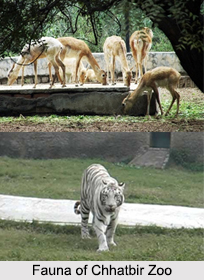 Chhatbir Zoo, also referred to as "Mahendra Chaudhary Zoological Park" is a beautiful zoological garden situated in the area of Zirakpur that is close to Chandigarh, the capital city of Punjab and Haryana. Over 82 species of reptiles, birds and mammals have been kept within the grounds of this northern Indian zoo which is particularly reputed for its Lion Safari. Developmental work was initiated in the 1970"s and currently the Chhatbir Zoo is an official zoological park of Chandigarh. Wildlife lovers throng this zoo especially to witness the Royal Bengal Tiger, and they are offered numerable trips to the natural habitats of the Asiatic Lions who wander freely in gay abandon amongst the zoo grounds. The Chhatbir zoo"s prized possessions are its 80 species of rare animals and variegated birds, dappled in a multitude of colours as well as fishes and reptiles. The total livestock of the zoo amounts to 850. The zoo had been planned in such a manner that the floral and natural beauty of this zoo enhanced its overall physical appearance.
Chhatbir Zoo, also referred to as "Mahendra Chaudhary Zoological Park" is a beautiful zoological garden situated in the area of Zirakpur that is close to Chandigarh, the capital city of Punjab and Haryana. Over 82 species of reptiles, birds and mammals have been kept within the grounds of this northern Indian zoo which is particularly reputed for its Lion Safari. Developmental work was initiated in the 1970"s and currently the Chhatbir Zoo is an official zoological park of Chandigarh. Wildlife lovers throng this zoo especially to witness the Royal Bengal Tiger, and they are offered numerable trips to the natural habitats of the Asiatic Lions who wander freely in gay abandon amongst the zoo grounds. The Chhatbir zoo"s prized possessions are its 80 species of rare animals and variegated birds, dappled in a multitude of colours as well as fishes and reptiles. The total livestock of the zoo amounts to 850. The zoo had been planned in such a manner that the floral and natural beauty of this zoo enhanced its overall physical appearance.
History of Chhatbir Zoo
It is said that the Maharaja of Patiala used to perform shooting at the place where today the Chhatbir Zoo is located. Shri Mahendra Mohan Chaudhury, the Governor of Punjab had inaugurated the Chhatbir Zoo on 13th April in the year 1977. Thereafter the zoological park was renamed as the "Mahendra Chaudhury Zoological Park". Initially only a few animals were introduced into Chhatbir Zoo, from Guwahati Zoo which is present in Assam. With the passage of time, this zoo came to be recognised as the biggest zoo of northern portion of India.
Geography of Chhatbir Zoo
Chhatbir Zoo occupies an area which measures 202 acres and is existent at a distance of nearly 55 kms away from Patiala and 17 kms away from Chandigarh. It is based on the right banks of Ghaggar River, overlooking the Shivalik Hills with a stunning green backdrop.
 Flora of Chhatbir Zoo
Flora of Chhatbir Zoo
A wide variety of flora can be observed in Chattbir Zoo including Parkinsonia, Shisham, Eucalyptus, Mulberry, Kadam, Lasura, Cassias, Acacias and Jamun amongst many others. Cynodons, Xanthiums, Murrayas and Saccharum reeds are also found here.
Fauna of Chhatbir Zoo
The large number of mammals who are sheltered here comprise Blackbuck, Sloth Bear, Chinkara, African Buffalo, Civet, Barking Deer, Leopard, Lion-Tailed Macaque, Sambhar, Spotted Deer, Jaguar, Gaur, Jackal, Hyena, White Tiger, Porcupine, Zebra, Royal Bengal Tiger, Indian Elephant, Four-horned Antelope, etc. The zoo is also a safe haven for plenty of birds like Budgerigar, Crane Sarus, Spotted Dove, White Ibis, Red Jungle Fowl, Combed Duck, Emu, Common Geese, Rose Ringed Parakeet, Indian Peafowl, Black Partridge, Grey Partridge, Rosy Pelicans, Golden Pheasant, White Pigeon, Black Pigeon, Painted Stork, Barheaded Geese, Shikra, Common Quail and numerous others. The animals are kept in open enclosures so that their behavioural and physical needs can be met akin to their natural habitat.
Visitors will be welcomed into the zoo with an artificial lake wherein many migratory birds assemble, especially during the months of winter. There exists a lush green lawn or compound near the zoo lake which increases the charm of the Chattbir Zoo.
Visiting Information of Chhatbir Zoo
The Chhatbir Zoo in Chandigarh is open 6 days a week and is closed on Monday. The zoo is open from 9.00 AM to 5.00 PM. The Chhatbir Zoo also offers a unique opportunity to go on a Lion Safari. Private vehicles are not allowed inside the Chhatbir Zoo.















